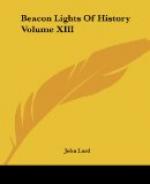The secure possession, by the stage, of the public mind, is of the first importance to the poet who works for it. He loses no time in idle experiments. Here is audience and expectation prepared. In the case of Shakspeare there is much more. At the time when he left Stratford and went up to London, a great body of stage-plays of all dates and writers existed in manuscript and were in turn produced on the boards. Here is the Tale of Troy, which the audience will bear hearing some part of, every week; the Death of Julius Caesar, and other stories out of Plutarch, which they never tire of; a shelf full of English history, from the chronicles of Brut and Arthur down to the royal Henries, which men hear eagerly; and a string of doleful tragedies, merry Italian tales, and Spanish voyages, which all the London ’prentices know. All the mass has been treated, with more or less skill, by every playwright, and the prompter has the soiled and tattered manuscripts. It is now no longer possible to say who wrote them first. They have been the property of the Theatre so long, and so many rising geniuses have enlarged or altered them, inserting a speech or a whole scene, or adding a song, that no man can any longer claim copyright in this work of numbers. Happily, no man wishes to. They are not yet desired in that way. We have few readers, many spectators and hearers. They had best lie where they are.
Shakspeare, in common with his comrades, esteemed the mass of old plays waste stock, in which any experiment could be freely tried. Had the prestige which hedges about a modern tragedy existed, nothing could have been done. The rude warm blood of the living England circulated in the play, as in street-ballads, and gave body which he wanted to his airy and majestic fancy. The poet needs a ground in popular tradition on which he may work, and which, again, may restrain his art within the due temperance. It holds him to the people, supplies a foundation for his edifice, and in furnishing so much work done to his hand, leaves him at leisure and in full strength for the audacities of his imagination. In short, the poet owes to his legend what sculpture owed to the temple. Sculpture in Egypt and in Greece grew up in subordination to architecture. It was the ornament of the temple wall: at first a rude relief carved on pediments, then the relief became bolder and a head or arm was projected from the wall; the groups being still arranged with reference to the building, which serves also as a frame to hold the figures; and when at last the greatest freedom of style and treatment was reached, the prevailing genius of architecture still enforced a certain calmness and continence in the statue. As soon as the statue was begun for itself, and with no reference to the temple or palace, the art began to decline: freak, extravagance, and exhibition took the place of the old temperance. This balance-wheel, which the sculptor found in architecture, the perilous irritability of poetic talent found in the accumulated dramatic materials to which the people were already wonted, and which had a certain excellence which no single genius, however extraordinary, could hope to create.




